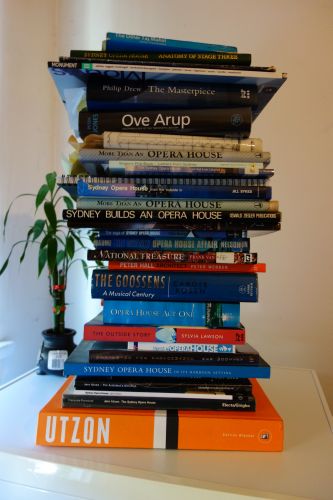History matters: an
introduction to the kaleidoscope series
Paul
Bentley
23 October 2013
The more a news
story gets compressed, the more it seems it deserves no more space than
it got allocated. - Alain de Botton, Twitter, 2013.
As we celebrate the
40th anniversary of the Sydney Opera House, the Wolanski Foundation begins a
series of short pieces about the building’s history.
History
 |
| Some of the books about Jørn Utzon
and the Sydney Opera House |
Writing history is a
messy and complicated matter involving the interpretation of facts and the
sifting of opinion.
Canadian historian Michael Welton put it this way: “we are entering into a
conversation with the past in order to illuminate the multiple meanings and
possibilities of the present in a dialogue with others who may be telling
different stories.”
Contexts need to be factored in. It is advisable to travel in the shoes of
the players who shaped the story. Reading between the lines calls for
perspicacity as well as a trail of evidence. We could well follow in the
steps of Thucydides, who set standards for persistence in digging up the
facts and objectivity in presenting them.
The histories of public institutions present special challenges. Most
organisations, understandably, present themselves in the best possible
light. The dirty laundry is usually hidden. A better understanding of their
history, speakers at a recent Australian Historical Association conference
argued, could avoid repetition of past mistakes or questionable decisions
based on a poor understanding of the past.
Sydney Opera House history
Many books have been published and movies made about the transformation of
the Opera House from poetic gesture to national icon. Its iconic status is
coloured by the tortured history that accompanied its design, construction
and operations.
There is still much to discover. Existing records warrant more careful
study. Elusive sources need to be tracked down.
The genesis of the building has never been accurately told. There has been a
focus on the period 1954 to 1973. Myths are perpetuated. From the
time Jørn Utzon won the competition, heroes and villains in the story have
swapped hats decade by decade. A well-researched history of the management
of the building awaits the services of an historian.
Views about the history continue to evolve. It has been the tendency of new
generations to compress the experience of their predecessors as they focus
attention on shaping the future. The compression has led to distortions that
need to be corrected.
My own views have changed during a 40-year preoccupation with preserving and
interpreting the building’s history. It is a journey that has made me more
circumspect about many aspects of the popular narrative and more
appreciative of those who show us the smoke and mirrors.
Sydney Opera House CEO Louise Herron touched on perennial interest in her
introduction to the 40th anniversary of the book, Building a Masterpiece.
“As we launch into a new chapter in its life, it is inspiring to delve back
into the building that put Australia on the map and that is one of the
masterpieces of the 20th century.”
Anniversaries are occasions for celebration and taking stock. The temptation
for hype is irresistible. The risk of hagiography is high.
As the Wolanski Foundation continues its work on a more detailed account of
the history of the iconic building and the way the story is preserved, we
turn the kaleidoscope to see where the coloured glass falls.
The Wolanski Foundation
The Wolanski family was a major funder of the Dennis Wolanski Library and
Archive of the Performing Arts at the Opera House from 1973 to 1997. The
Wolanski Foundation has published material about the Sydney Opera House and
responded to enquiries about the House since 1998. The Wolanski family
provided financial support for Opera House digitisation programs in 2011 and
for the restoration of the film Autopsy on a Dream, a collaboration
of the Sydney Opera House and Australian Broadcasting Corporation, in 2013.
Paul Bentley headed the Dennis Wolanski Library from 1973 to1997 and
developed the Sydney Opera House oral history program, which recorded nearly
50 interviews with architects, engineers, politicians and others. He curated
the Building of the Century Exhibition in 1988-1989, presented the
Sydney Opera House Travelling Exhibition in Europe, the United States
and Asia 1994-1995 and was instrumental in the presentation of the Unseen
Utzon Exhibition, a joint venture of the Sydney Opera House Trust and
State Library of New South Wales, 1994-1995. His article on Clarice Lorenz,
who - as founder of the NSW National Opera - played an under-acknowledged
role in the establishment of the Opera House, appears in the latest volume
of the Australian Dictionary of Biography.
Turning the Kaleidoscope series
Among articles in the pipeline:
Spinning fantasy: Sydney Opera House myths
Autopsy on Autopsy on a Dream
Leif Kristensen
Launching the Opera House
Related articles and pages
The Sydney Opera House story: a chronology
Sydney Opera House: an annotated list of sources
Sydney Opera House: site, design,
construction, costs
Utzon and the Opera House: as it happened
1918-2000
A matter of integrity: a review of Yuzo
Mikami’s book Utzon’s Sphere
Frank Barnes 1926-2005: the model of a
general manager
Being There Without Being There: the
arts in the age of YouTube
Catching Lightning in a Bucket:
archiving the performing arts in the digital era